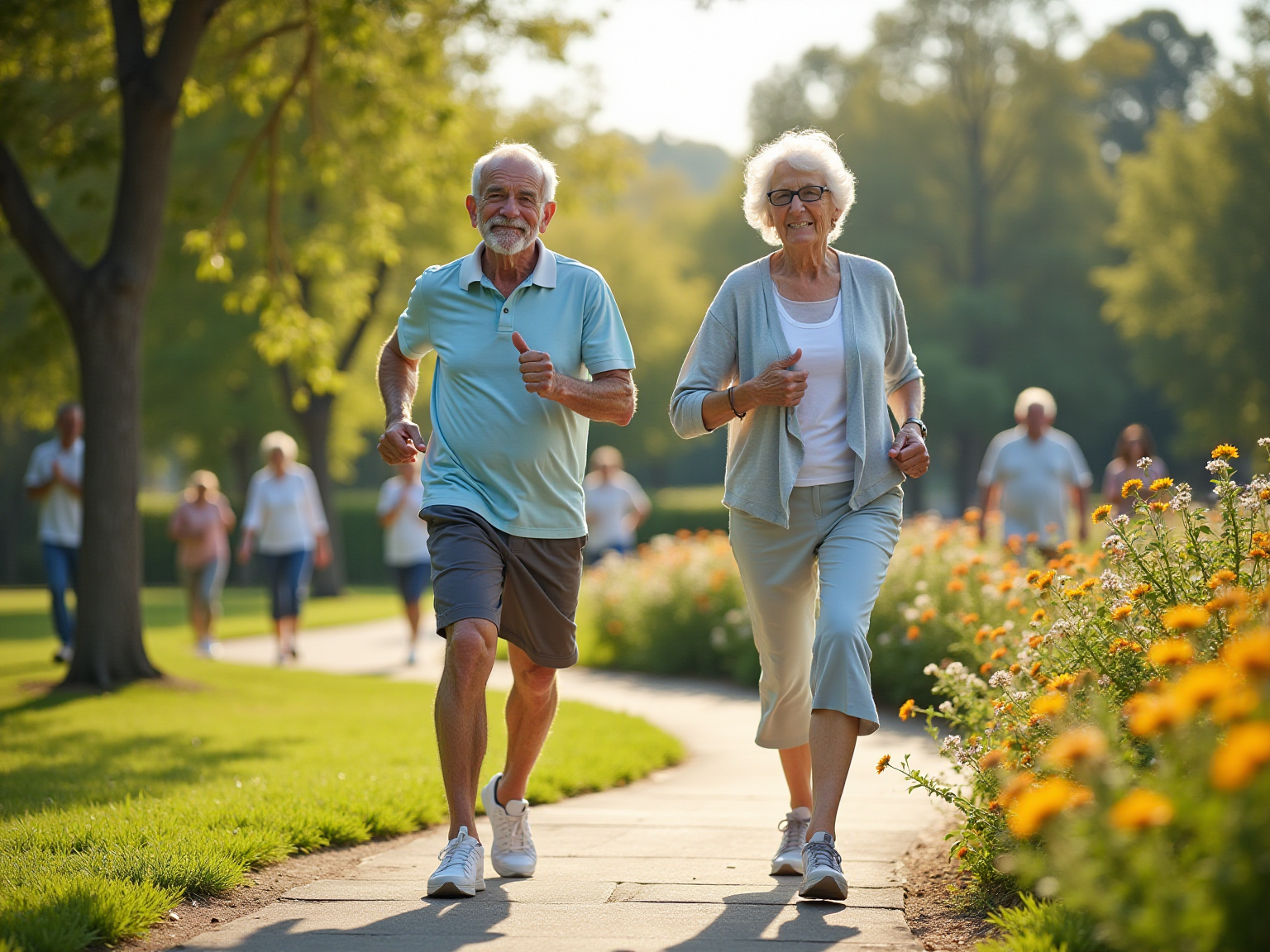Why a Fitness Protocol is Essential for Healthy Aging
Overview
A fitness protocol is essential for healthy aging. It significantly enhances physical function, mental well-being, and helps prevent chronic diseases among older adults. Regular exercise improves muscle mass, cardiovascular health, and mental health. Furthermore, it reduces healthcare costs associated with inactivity. This underscores the importance of fitness in promoting a vibrant, independent lifestyle as one ages.
As we explore the benefits of fitness, consider how incorporating regular exercise into daily routines can lead to a healthier, more fulfilling life. The evidence is clear: staying active is not just about physical health; it also contributes to mental clarity and emotional resilience.
In conclusion, adopting a fitness protocol is not merely beneficial; it is vital for thriving in later years. Explore further resources to find effective exercise programs tailored to your needs and start your journey toward healthier aging today.
Introduction
As the population ages, the significance of fitness in promoting healthy aging becomes increasingly evident. Engaging in regular physical activity is not merely about maintaining strength; it plays a crucial role in enhancing cardiovascular health, mental well-being, and overall quality of life for older adults. With the alarming rise of chronic conditions linked to inactivity, understanding the profound impact of exercise on aging is essential.
Consider the inspiring lifestyle of the Hunza Valley residents, who exemplify the benefits of integrated physical activity. Their experience highlights how fitness can transform lives. Additionally, the economic implications of sedentary behavior further complicate the conversation around fitness and aging, making it multifaceted. This article delves into the critical role of structured fitness protocols, the dangers of a sedentary lifestyle, and alternative perspectives on staying active. Ultimately, it underscores how embracing movement today can lead to a healthier tomorrow.
Understand the Role of Fitness in Healthy Aging
Fitness is essential to robust aging, significantly improving bodily function, cardiovascular fitness, and mental well-being. Consistent exercise is crucial for maintaining muscle mass, which naturally decreases with age, and it aids metabolic functions necessary for sustaining energy equilibrium. Research shows that consistent exercise can counteract age-related changes, such as decreased bone density and a heightened risk of chronic diseases. Notably, four out of five of the most expensive chronic conditions among individuals aged 50 and above can be prevented or controlled through exercise.
Furthermore, fitness serves an essential function in mental well-being, reducing symptoms of anxiety and depression that are frequently common in older individuals. The National Institute on Aging emphasizes that exercise is vital for preserving independence and improving quality of life as one grows older, rendering it a crucial element of a healthy aging plan. A persuasive case study highlights the economic impact of inactivity, showing that non-institutionalized individuals aged 50 and above allocate around $860 billion each year for healthcare, a significant portion of which could be reduced through enhanced exercise. Encouraging regular exercise not only fosters substantial healthcare savings but also improves the overall quality of life for older adults.
Moreover, the lifestyle of the Hunza Valley inhabitants illustrates the advantages of natural exercise. Their rigorous farming methods and daily manual work contribute to their impressive fitness levels, demonstrating how consistent, integrated exertion can enhance longevity and health. As we approach 2025, the significance of exercise for seniors remains evident, with continuous research required to further confirm the advantages of high-intensity workouts. Community planning initiatives should promote the establishment of secure and accessible areas for exercise, ensuring that senior citizens have access to the resources they require to remain active. Ultimately, adopting a fitness protocol today can lead to a healthier, more vibrant future. As Karen Lamb wisely stated, ‘A year from now, you will wish you had started today.
Explore the Benefits of a Structured Fitness Protocol
A structured fitness protocol provides numerous advantages, which are particularly important for older individuals. These programs typically include a balanced mix of aerobic, strength, flexibility, and balance exercises, all collaborating to improve capabilities and reduce the risk of falls. Research suggests that older adults following a structured exercise routine experience significant enhancements in cardiovascular condition, muscle strength, and joint mobility. Notably, a meta-analysis showed that participating in at least 150 minutes of moderate exercise each week can reduce the risk of death from all causes by 31%. Furthermore, these structured fitness protocols promote social interaction, effectively combating loneliness and enhancing mental well-being, thereby supporting a comprehensive approach to healthy aging.
The activity routines of the Hunza Valley inhabitants illustrate this point; their strenuous farming methods and natural forms of exercise contribute to their extraordinary longevity and well-being. As they engage in regular physical labor, they not only maintain high levels of fitness but also benefit from enhanced metabolic efficiency. Additionally, the collaboration between TMG and NMN emphasizes the significance of aiding cellular function as one ages; while NMN reduces methyl groups, TMG provides them, ensuring optimal cellular well-being.
As Peggy Fleming insightfully stated, “I think exercise tests us in so many ways: our skills, our hearts, our ability to bounce back after setbacks. This is the inner beauty of sports and competition, and it can benefit us all as athletes.” This perspective reinforces the idea that fitness is a personal journey. Moreover, as Felicity Lucky wisely pointed out, individuals with fitness objectives often thrive due to having clear guidance, which underscores the significance of a fitness protocol in attaining enduring wellness advantages.
Examine the Consequences of a Sedentary Lifestyle
A sedentary lifestyle poses significant risks to well-being, especially for older adults. Extended periods of inactivity are associated with a range of adverse health outcomes, including obesity, cardiovascular disease, diabetes, and cognitive decline. The term ‘sitting disease’ captures the dangers of excessive sitting, which can contribute to metabolic syndrome and increased mortality rates. Research indicates that older individuals who engage in minimal physical activity face a higher likelihood of developing chronic conditions and experiencing functional decline. Alarmingly, the CDC highlights that sedentary behavior can exacerbate feelings of anxiety and depression, complicating the well-being landscape for aging populations.
Furthermore, a study by Raichlen DA titled ‘Sedentary behavior and incident dementia among older individuals’ underscores the cognitive risks associated with inactivity. Insufficient sleep, too, has been negatively linked to cognitive function, overall well-being, and immune strength, further complicating the aging process. Notably, four out of five of the most costly chronic conditions among adults aged 50 and older are preventable or manageable through a fitness protocol that includes regular exercise. This underscores the importance of recognizing the risks associated with a sedentary lifestyle, as the insights gained from innovative research, including Dr. Joseph Dituri’s underwater experiments, highlight the potential for new fitness protocols aimed at enhancing well-being and longevity. Additionally, the longevity practices of the Hunza community, who prioritize active lifestyles and nutritious diets, remind us of the critical role of exercise in achieving optimal health. In addition, the WHO’s Call for Action on Exercise emphasizes the need for a comprehensive societal approach to promote movement, advocating for greater investments and partnerships to create environments that facilitate safe and enjoyable exercise.
This awareness is vital for encouraging a shift towards more active living, ultimately fostering improved wellness as individuals age. By integrating exercise with informed nutritional choices, individuals can significantly enhance their overall well-being and lifespan.

Consider Alternative Perspectives on Fitness and Aging
While the benefits of fitness for healthy aging are well-documented, alternative perspectives challenge conventional views. Critics contend that organized physical activity may not be ideal for all, particularly individuals with chronic medical conditions or mobility restrictions. Instead, a comprehensive approach promotes incorporating exercise into daily life through unconventional methods like gardening, walking, or engaging in social pursuits that involve movement.
Studies show that expenses related to inactivity make up more than 11% of overall care spending, totaling around $117 billion each year. This statistic emphasizes the urgent necessity for effective strategies to encourage engagement among older adults, particularly through a fitness protocol that utilizes alternative methods which can be more accessible and enjoyable.
Experts stress the significance of mental and emotional well-being alongside the fitness protocol, highlighting that stress management and social connections are vital for healthy aging. The exercise routines of the Hunza Valley inhabitants illustrate this, as their daily habits include rigorous farming tasks and natural methods of exercise that enhance their longevity and overall well-being.
Furthermore, the collaboration between TMG and NMN is crucial for improving cellular function, ensuring the body efficiently uses NMN for maximum wellness advantages. Programs such as EnhanceFitness and Walk With Ease are designed as part of a fitness protocol specifically created to serve senior individuals by offering organized yet adaptable settings that promote exercise in a nurturing community.
Creating walking groups and companion systems can provide the social assistance needed to inspire older adults to participate in physical activity, resulting in enhanced well-being.
This viewpoint promotes finding pleasurable and lasting methods to remain active, instead of strictly following formal exercise routines. By recognizing the diversity of fitness approaches and their specific benefits for healthy aging, individuals are empowered to select paths that resonate with their personal health goals and lifestyles, ultimately fostering a more holistic view of aging well.
Conclusion
Fitness is vital for healthy aging, significantly improving physical function, cardiovascular health, and mental well-being in older adults. Regular physical activity helps preserve muscle mass, supports metabolism, and prevents chronic diseases. With the rising healthcare costs associated with inactivity, structured fitness programs become essential for enhancing health outcomes. The lifestyle of the Hunza Valley residents exemplifies how integrated physical activity contributes to longevity.
Structured fitness protocols that include aerobic, strength, flexibility, and balance exercises not only improve physical health but also promote social interactions, reducing loneliness and fostering mental well-being. Furthermore, alternative methods of incorporating movement, such as gardening or walking, can also be effective and more accessible for those with mobility challenges.
The risks of a sedentary lifestyle are considerable, leading to obesity, cardiovascular issues, and cognitive decline. Research and examples from active communities, like the Hunza people, underscore the importance of physical activity in promoting health and longevity. By encouraging diverse fitness approaches and creating supportive environments, society can inspire individuals to embrace more active lifestyles.
Ultimately, prioritizing movement today is crucial for a healthier, more vibrant future. This emphasizes that the journey toward fitness enhances overall quality of life as one ages.
Frequently Asked Questions
Why is fitness essential for robust aging?
Fitness is essential for robust aging as it significantly improves bodily function, cardiovascular fitness, and mental well-being. It helps maintain muscle mass, aids metabolic functions, and counteracts age-related changes like decreased bone density and chronic disease risks.
How does exercise impact chronic diseases in older adults?
Research shows that four out of five of the most expensive chronic conditions among individuals aged 50 and above can be prevented or controlled through exercise, highlighting its importance in managing health as one ages.
What role does fitness play in mental well-being for seniors?
Fitness plays a crucial role in mental well-being by reducing symptoms of anxiety and depression, which are common in older individuals. Regular exercise is vital for preserving independence and improving quality of life.
What are the economic implications of inactivity in older adults?
Non-institutionalized individuals aged 50 and above spend around $860 billion each year on healthcare, a significant portion of which could be reduced through enhanced exercise, indicating that regular physical activity can lead to substantial healthcare savings.
How does the lifestyle of the Hunza Valley inhabitants relate to fitness and aging?
The Hunza Valley inhabitants exhibit impressive fitness levels due to their rigorous farming methods and daily manual work, demonstrating how consistent, integrated physical exertion can enhance longevity and health.
What should community planning initiatives focus on regarding senior fitness?
Community planning initiatives should promote the establishment of secure and accessible areas for exercise, ensuring that senior citizens have the resources they need to remain active and engaged in fitness activities.
What is the overall message regarding adopting a fitness protocol for aging?
Adopting a fitness protocol today can lead to a healthier, more vibrant future, emphasizing the importance of starting an exercise routine to improve quality of life as one ages.






